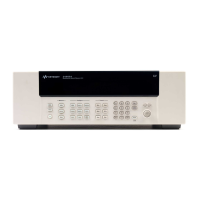Calibration Procedures 3
34980A Service Guide 51
Calibration Process
The following general procedure is the recommended method to complete a full
instrument calibration.
1 Read “DMM Test Considerations" on page 55 and “Plug-in Module Test
Considerations" on page 67.
2 Perform the verification tests to characterize the instrument (incoming data).
3 Unsecure the instrument for calibration (“Calibration Security" on page 49).
4 Perform the DMM adjustment procedures (“Internal DMM Adjustments" on
page 62).
5 Perform the DAC adjustment procedures if either the 34951A (“34951A 4-Ch
Isolated DAC Module" on page 68) or 34952A (“34952A Multifunction Module" on
page 73) is installed.
6 Secure the instrument against calibration.
7 Note the new security code and calibration count in the instrument’s maintenance
records.
Aborting a Calibration in Progress
Sometimes it may be necessary to abort a calibration after the procedure has already
been initiated. You can abort a calibration at any time on any module by turning off the
power. You can abort a calibration on the internal DMM or the 34951A 4-Ch Isolated
DAC by issuing a remote interface device clear message. You can abort a calibration on
the 34952A Multifunction Module by sending the
CALibration:ABORt command.
The 34951A 4-Ch Isolated DAC is intended to be adjusted frequently to
compensate for changes in the module’s environment. These
adjustments can be made either volatile or non-volatile. See page 68 for
details.
If you abort a calibration in progress when the instrument is attempting
to write new calibration constants to EEPROM, you may lose all
calibration constants for the function. Typically, upon re-applying
power, the instrument will report error 705 Cal:Aborted. You may also
generate errors 740 through 746. If this occurs, you should not use the
instrument until a complete re-adjustment has been performed. For a list
of calibration error numbers, see page 86.

